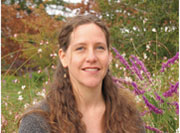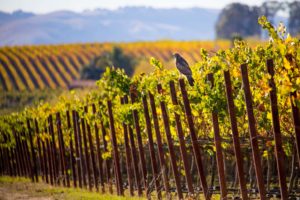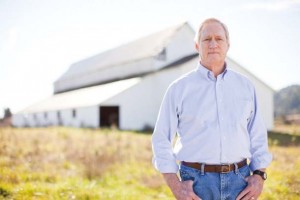From a modern house on a knoll in the Nicasio Valley, Randy Lafranchi, fifth-generation Marin County dairyman and second-generation easement partner, surveys his family’s domain. Most of its 1,200 acres, from ridgetop to county road to water district reservoir, lie within view. Beyond, the bowl of Nicasio rises to rims of hills. North slopes are shaggy with redwoods; south slopes—like the one we’re on—sweeping and open, with grasses autumn-yellow but still softening the contours of the land. A tiny cluster of buildings off to the left is the village of Nicasio.
As one of the county’s oldest family ranches, the Lafranchi spread had come to have multiple owners, only one of whom, Randy’s father, Wilfred, actually stayed on and farmed the land. Nobody in the family wanted development, but how could the value of this property be shared without dismantling it?
In the 1980s, the family took action. In a rather intricate deal, it gave an easement on the home ranch to the county in return for the right to build some houses on a nonagricultural parcel on the other side of Nicasio. This transaction allowed the urban family members to realize some gains. At the same time, Wilfred and Mary teamed up with MALT to add 460 acres of valuable adjoining pasture: MALT purchased the development rights, and the Lafranchis acquired the land itself at a price reflecting its farm value. As a result of these steps, the Lafranchi operation went on a more solid footing.
After the Lafranchis took the plunge, several neighbors also sold easements to MALT, creating a belt of protected land along the north side of Nicasio Valley Road. The old uncertainty about the future—the “how much longer?” feeling—began to fade.
Lafranchi’s easement agreement with MALT, which dates to the beginning of what might be called the easement era, contains only broad language about maintaining soil and water quality and retaining the land profile. “They come around and check your pastures and so forth to be sure you’re not overgrazing or whatever,” says Randy. “We’ve had a good working relationship for 20 years. It doesn’t seem like a burden, not at all.” The county-owned easement, which merely re­quires the continuation of agriculture, receives no monitoring.
Dairying remains a fight for survival, and Randy Lafranchi, like many of his neighbors, has branched out. On one corner of his ranch is a composting operation, mixing animal waste with suburban garden clippings to make a garden soil amendment. Eight acres along the road are leased to organic vegetable grower Marty Jacobson, an enthusiastic fellow who raises oddly shaped and beautifully colored heirloom tomatoes and other specialties for outlets like Woodland Markets, the Market Bar, and the Slanted Door restaurant in San Francisco’s Ferry Building.
This roadside garden is one of those spots in West Marin where the urban and rural worlds meet. Drivers along the road stop off to look and buy and chat. In late September, the lot is merry with pumpkins. And for the last decade, the West Marin community and its East Marin friends have gathered here for MALT’s annual Harvest Day. Lafranchi is only too pleased to be the host. “It is wonderful that MALT came into our lives,” he says. “It’s made this all possible, really, to preserve the land that we love.”
Conservation Professional, Kellyx Nelson
- Photo by Saul Chaikin
Some easement owners, like MALT, use their own staff exclusively to monitor easements. Others, like the Peninsula Open Space Trust, train volunteers to be their eyes and ears. But when controversies arise, they wind up in the hands of a professional—perhaps those of Kellyx Nelson, whose title, conservation project manager, covers this and several other delicate and fascinating tasks.
Working with easements on the San Mateo coastside, Nelson is an enforcer of sorts. She is also—with every move she makes—a roving ambassador to a largely skeptical community. “I spend a lot of my time building relationships with farmers, landowners, equipment dealers, businessmen, hunters. People feeling under pressure,” she says. “They don’t know where to place their frustration with the world that’s changing around them.” It is part of her job to demonstrate that POST is sometimes in a position to help.
Nelson has now watched several easements take shape—most recently on the Arata Ranch—and observed that the process is best undertaken slowly. “You have to really know the owner; you have to really know the land.” If any issues arise later on, it is important to be reasonable and flexible. It is also important to be explicit with landowners and to make sure that the values for which an easement was created stay intact. “You are not their best friend. There’s a fine line, and I walk it all the time.”
But the conversation, she hastens to add, goes both ways. Nelson emphasizes how much she has learned from people on the land. She was impressed, for instance, to see how the manager of San Gregorio Farms, an easement property next door to the Aratas, made grazing cattle a tool against erosion on a slope with incipient gullies. The heavy animals recontoured the ground and crushed gopher holes that were serving as water conduits (“pipes”). Nelson is now incorporating this idea into a carefully managed grazing program on one of POST’s fee simple properties.
Nelson’s background equips her for these complex roles at the trust. She has driven a truck, run youth programs at summer camps, and during seven years at the California Academy of Sciences, launched a program to bring inner-city youths into hands-on science. When she signed on with the trust in 2004, she thought she would now be working “with the land itself—it wouldn’t be all about people. I couldn’t have been more wrong.”

.jpg)



-300x199.jpg)
-300x199.jpg)